Industrial Salts Market Size
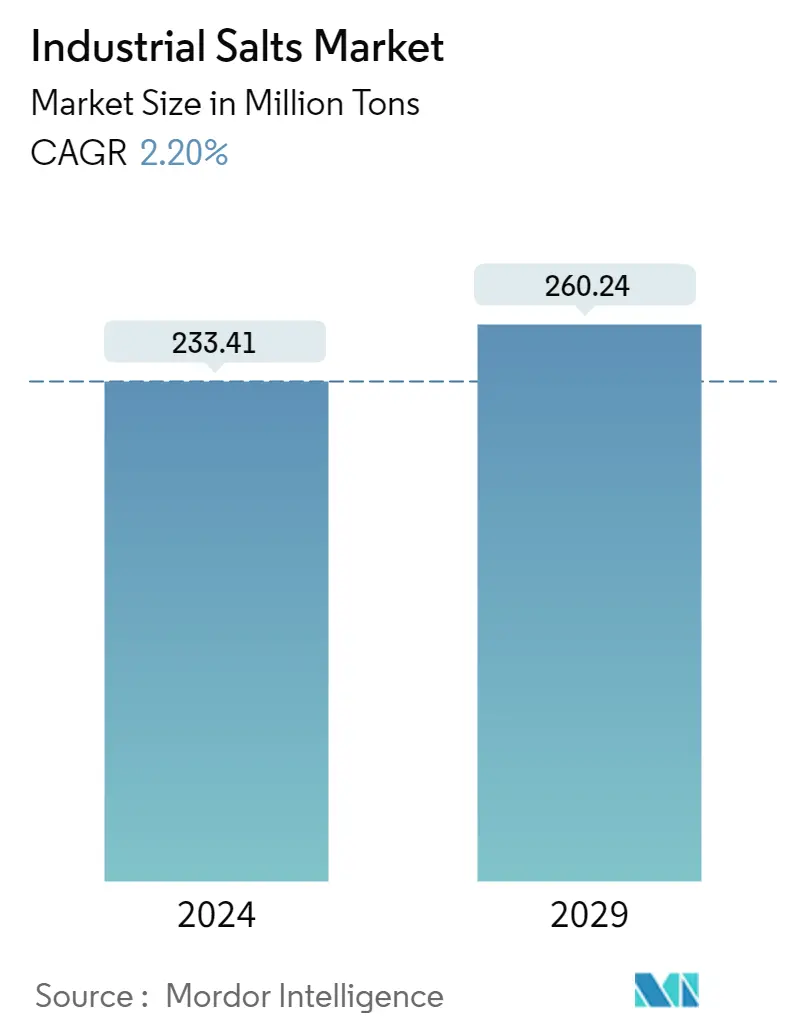
| Study Period | 2019 - 2029 |
| Market Volume (2024) | 233.41 Million tons |
| Market Volume (2029) | 260.24 Million tons |
| CAGR (2024 - 2029) | 2.20 % |
| Fastest Growing Market | Asia Pacific |
| Largest Market | Asia Pacific |
| Market Concentration | Low |
Major Players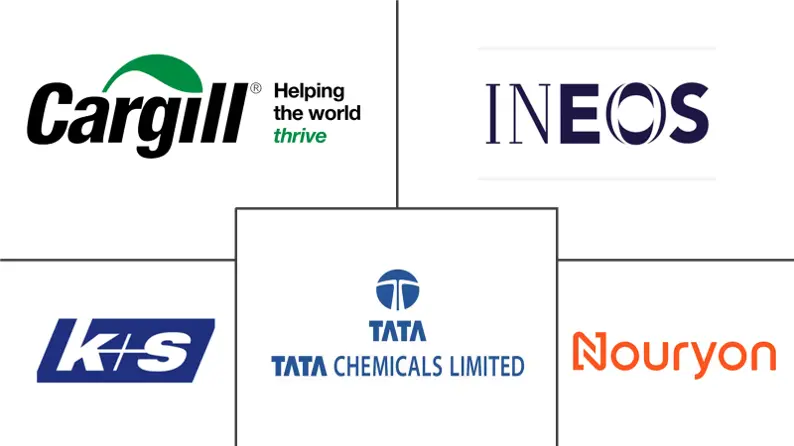
*Disclaimer: Major Players sorted in no particular order |
Industrial Salts Market Analysis
The Industrial Salts Market size is estimated at 233.41 Million tons in 2024, and is expected to reach 260.24 Million tons by 2029, growing at a CAGR of 2.20% during the forecast period (2024-2029).
The market was negatively impacted by COVID-19 in 2020. Industrial salts are used to produce chemicals like chlorine and caustic soda. Owing to the pandemic scenario, the chemical manufacturing units were on a temporary halt during the government-imposed lockdown, thus leading to a decrease in the demand for raw material needed in chemical processing. Furthermore, industrial salts are also consumed in paper manufacturing. According to the CONFEDERATION OF EUROPEAN PAPER INDUSTRIES (CEPA), the paper and board production by Cepi member countries decreased by 5% in 2020 compared to the previous year, mainly due to global demand impacted by the COVID-19 pandemic, which in turn negatively impacts the demand for the studied market. However, the usage of soaps and detergents that use industrial salts as a raw material during production has significantly increased during this situation, considering the personal hygiene and clean surrounding, which in turn stimulates the demand for the industrial salts market.
- Over the short term, the increasing demand for industrial salts for chemical processing and water treatment applications is expected to drive the market's growth.
- On the flip side, strict regulations imposed by the environmental protection agency (EPA) are expected to hinder the growth of the market.
- By application, the chemical processing segment is expected to dominate the market, owing to the increasing usage in manufacturing soda ash, caustic soda, and chlorine.
- The Asia-Pacific region dominated the market across the world, with the largest consumption from countries such as China and India.
Industrial Salts Market Trends
This section covers the major market trends shaping the Industrial Salts Market according to our research experts:
Increasing Demand from Chemicals Processing Application
- Industrial salts are manufactured from rock salt or natural brine by conventional mining, solar evaporation, and vacuum evaporation.
- Chemical processing applications account for over 50% of the total industrial salts demand. Industrial salts are widely used for manufacturing chlorine, soda ash, and caustic soda, owing to their availability in large quantities and cost-effectiveness.
- Due to the lack of cost-effective substitutes, industrial salts are actively used in the chloralkali process to manufacture products such as ethylene dichloride, which is stimulating the demand for industrial salts.
- According to the American Chemistry Council, the annual production growth of the chemical industry in the United States is likely to rise by about 12.3% in 2021 compared to the previous year. The total chemical capital expenditure is likely to rise to USD 33.5 billion by 2021, with a growth rate of 15.7% compared to the previous year, which in turn is expected to stimulate the market demand for industrial salts.
- Industrial salts are used in the production of plastics, including polyvinyl chloride, soaps, detergents, herbicides, and pesticides. It is also used in the production of inorganic chemicals like titanium dioxide, enhancing the growth of the industrial salts market.
- The laundry care segment also consumes industrial salts for manufacturing detergents, soaps, and other laundry care products. The US laundry care market was valued at about USD 12.8 billion in 2019 and reached about USD 13.1 billion in 2020, with a growth rate of about 2%, stimulating the demand for the studied market.
- Therefore, the aforementioned factors are expected to significantly impact the market in the coming years.
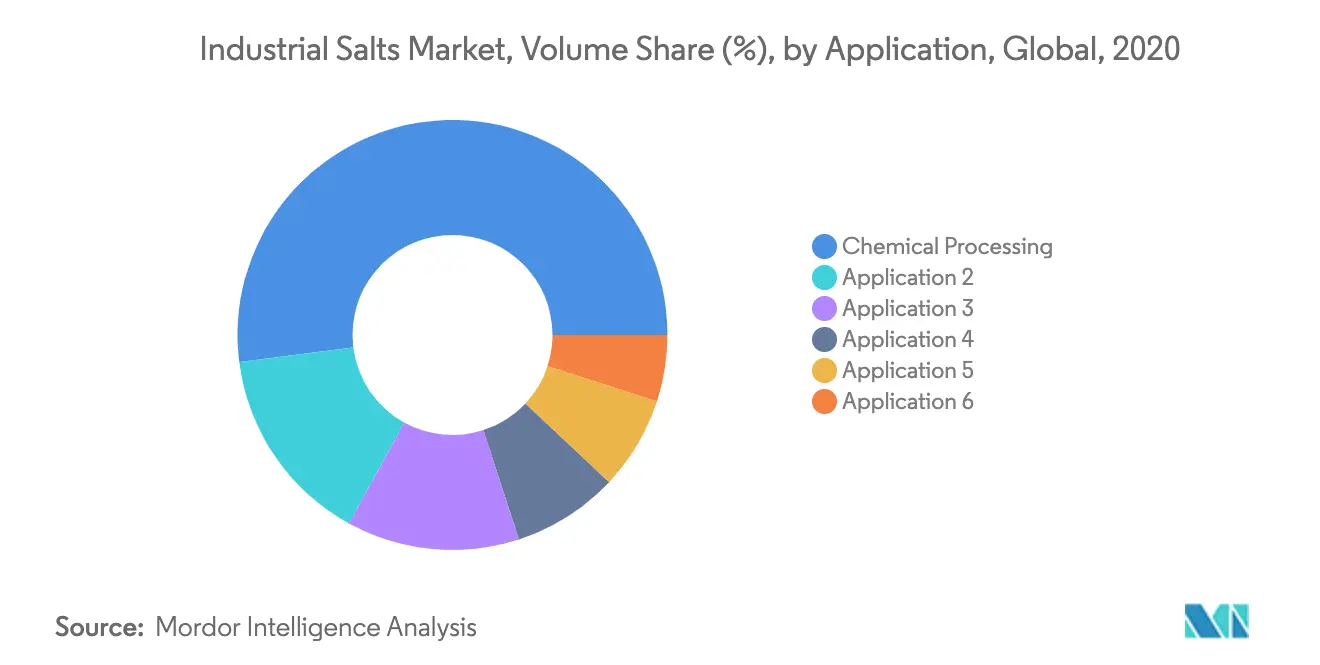
Asia-Pacific Region to Dominate the Market
- The Asia-Pacific region is expected to dominate the market for industrial salts during the forecast period, owing to the growing industrialization in the region. In countries like China, India, and Japan, due to the usage of industrial salts in the chemicals processing industry, the demand for industrial salts has been increasing.
- The Japanese chemical industry was valued at about USD 200 billion in 2019, with a growth rate of about 2.5% compared to the previous year, which in turn stimulates the market demand for industrial salts.
- Industrial salts are widely used for de-icing for clearing roadways in countries with heavy snowfall. De-icing property of industrial salts also helps to delay the reformation of ice for a certain period of time.
- In water treatment plants, industrial salts are used for the water softening and purification process. In countries like India and China, many water treatment projects are being constructed, which is likely to help stimulate the growth of industrial salts over the forecast period.
- The plastic segment uses industrial salts to produce polyvinyl chloride (PVC), which are widely used in the construction industry for different applications, including piping, PVC boards, and others. China was leading the construction industry with market size of USD 1,092.9 billion in 2019, registering a growth rate of 14.71% compared to the previous year.
- Furthermore, the total new construction in Japan accounted for about 127.55 million sq. m in 2019 and reached about 113.74 million sq. m in 2020, with a decline rate of about 10.5%. This led to a decrease in consumption of PVC-made construction materials, in turn stimulating the demand for the industrial salts market.
- Some major companies operating in the Asia-Pacific region include Cargill Incorporated, K+S Aktiengesellschaft, and Tata Chemicals Ltd.
- Therefore, the aforementioned factors are expected to significantly impact the market in the coming years.
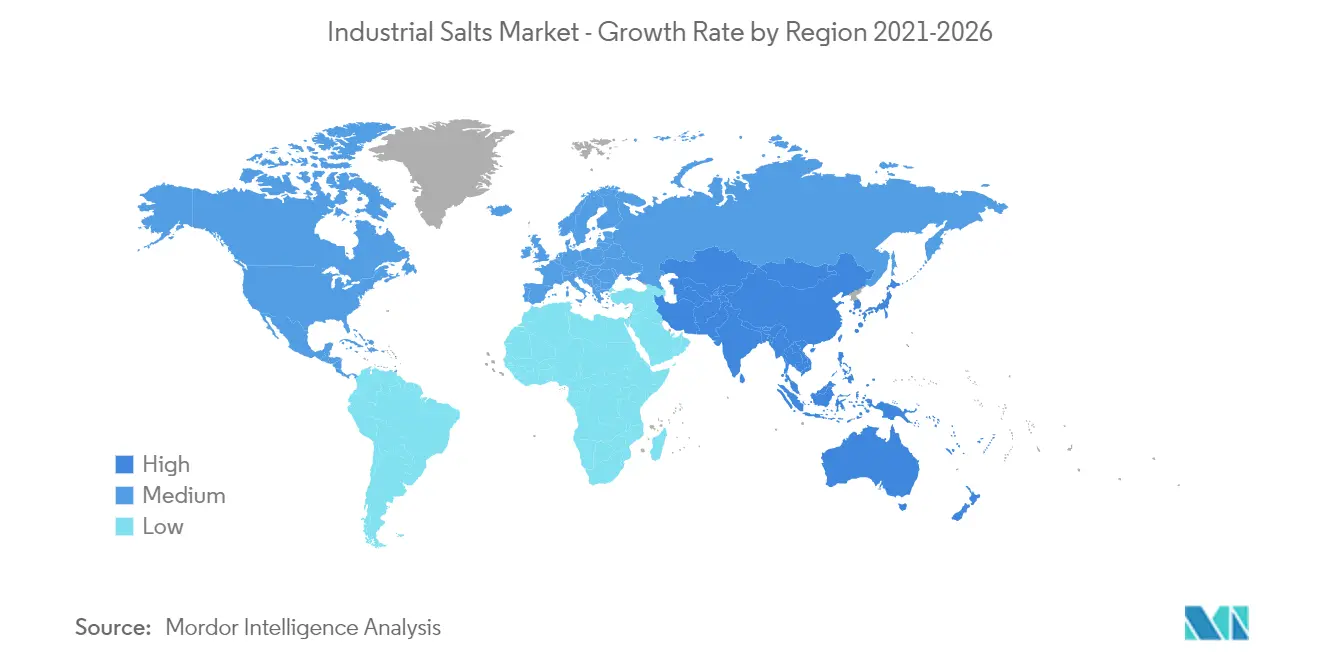
Industrial Salts Industry Overview
The industrial salts market is fragmented, with the top five players accounting for a marginal share of the market. Some key players in the market include Cargill Incorporated, K+S Aktiengesellschaft, Tata Chemicals Ltd, INEOS, and Nouryon.
Industrial Salts Market Leaders
-
Cargill, Incorporated
-
K+S Aktiengesellschaft
-
Tata Chemicals Ltd.
-
INEOS
-
Nouryon
*Disclaimer: Major Players sorted in no particular order
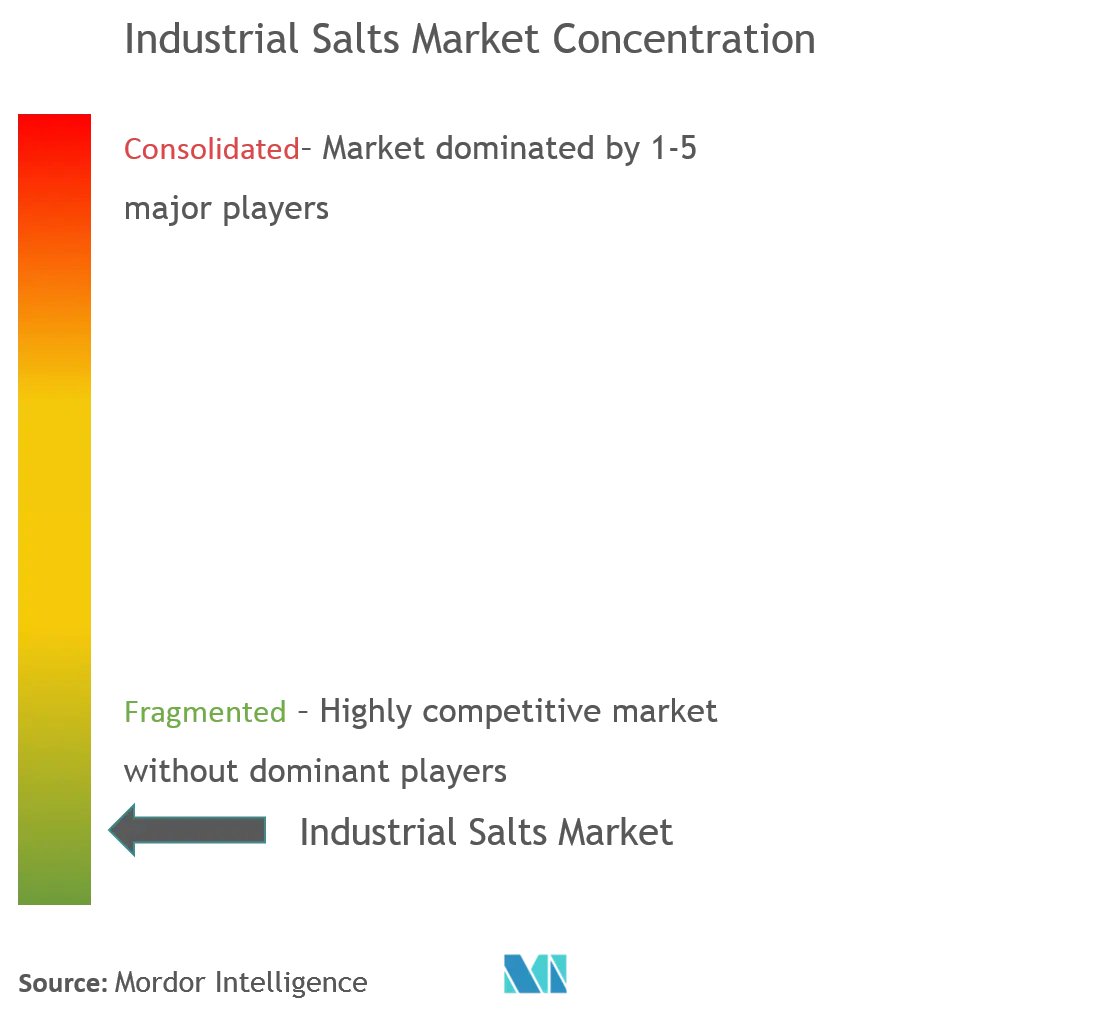
Industrial Salts Market News
- In January 2021, Tata Chemicals Ltd intended to acquire the industrial salt unit with an annual production capacity of 3 million tons of Archean Group, which would enhance the company's business.
- In June 2018, Ajax Equipment supplied a new salt handling system to optimize salt tablet production at the Runcorn facility of INEOS, comprising two screw conveyors and a screw feeder. INEOS Salt produces up to 500 kilotons of salt annually, including food salts, water softening tablets, animal feed, industrial and chemical, and de-icing salts.
Industrial Salts Market Report - Table of Contents
1. INTRODUCTION
1.1 Study Assumptions
1.2 Scope of the Study
2. RESEARCH METHODOLOGY
3. EXECUTIVE SUMMARY
4. MARKET DYNAMICS
4.1 Drivers
4.1.1 Increasing Demand in Chemical Processing
4.1.2 Growing Demand from Water Treatment
4.2 Restraints
4.2.1 Stringent Government Regulations
4.2.2 Unfavorable Conditions Arising due to the Impact of COVID-19
4.3 Industry Value Chain Analysis
4.4 Porter's Five Forces Analysis
4.4.1 Bargaining Power of Suppliers
4.4.2 Bargaining Power of Consumers
4.4.3 Threat of New Entrants
4.4.4 Threat of Substitute Products and Services
4.4.5 Degree of Competition
5. MARKET SEGMENTATION
5.1 Source
5.1.1 Rock Salt
5.1.2 Natural Brine
5.2 Manufacturing Process
5.2.1 Solar Evaporation
5.2.2 Vacuum Evaporation
5.2.3 Conventional Mining
5.3 Application
5.3.1 Chemical Processing
5.3.2 Water Treatment
5.3.3 De-icing
5.3.4 Agriculture
5.3.5 Food Processing
5.3.6 Oil and Gas
5.3.7 Other Applications
5.4 Geography
5.4.1 Asia-Pacific
5.4.1.1 China
5.4.1.2 India
5.4.1.3 Japan
5.4.1.4 South Korea
5.4.1.5 Rest of Asia-Pacific
5.4.2 North America
5.4.2.1 United States
5.4.2.2 Canada
5.4.2.3 Mexico
5.4.3 Europe
5.4.3.1 Germany
5.4.3.2 United Kingdom
5.4.3.3 France
5.4.3.4 Italy
5.4.3.5 Rest of Europe
5.4.4 South America
5.4.4.1 Brazil
5.4.4.2 Argentina
5.4.4.3 Rest of South America
5.4.5 Middle-East and Africa
5.4.5.1 Saudi Arabia
5.4.5.2 South Africa
5.4.5.3 Rest of Middle-East and Africa
6. COMPETITIVE LANDSCAPE
6.1 Mergers and Acquisitions, Joint Ventures, Collaborations, and Agreements
6.2 Market Share**/Ranking Analysis
6.3 Strategies Adopted by Leading Players
6.4 Company Profiles
6.4.1 Archean Group
6.4.2 Cargill Incorporated
6.4.3 Compass Minerals
6.4.4 Delmon Group of Companies
6.4.5 Dominion Salt Limited
6.4.6 Donald Brown Group
6.4.7 Exportadora de Sal de CV
6.4.8 INEOS
6.4.9 K+S Aktiengesellschaft
6.4.10 MITSUI & CO. LTD
6.4.11 Morton Salt Inc.
6.4.12 Nouryon
6.4.13 Rio Tinto
6.4.14 Salins IAA
6.4.15 Tata Chemicals Ltd
- *List Not Exhaustive
7. MARKET OPPORTUNITIES AND FUTURE TRENDS
7.1 Technological Advancements to Produce High Purity Salts
7.2 Other Opportunities
Industrial Salts Industry Segmentation
Industrial salts are mainly consumed by the chemical industry to produce caustic soda and other chloralkali products and are also used in the manufacturing of polyester, glass, paper, tires, brass bleach, as well as used to set dye in the fabric. Industrial salts are available in various levels of purity, depending on the applications. The industrial salts market is segmented by Source, Manufacturing Process, Application, and Geography. By Source, the market is segmented into Rock Salt and Natural Brine. By Manufacturing Process, the market is segmented into Solar Evaporation, Vacuum Evaporation, and Conventional Mining. By Application, the market is segmented into Chemical Processing, Water Treatment, De-icing, Agriculture, Oil and Gas, and Other Applications. The report also covers the market size and forecasts for the industrial salts market in 15 countries across major regions. For each segment, the market sizing and forecasts have been done on the basis of volume (kilotons).
| Source | |
| Rock Salt | |
| Natural Brine |
| Manufacturing Process | |
| Solar Evaporation | |
| Vacuum Evaporation | |
| Conventional Mining |
| Application | |
| Chemical Processing | |
| Water Treatment | |
| De-icing | |
| Agriculture | |
| Food Processing | |
| Oil and Gas | |
| Other Applications |
| Geography | |||||||
| |||||||
| |||||||
| |||||||
| |||||||
|
Industrial Salts Market Research FAQs
How big is the Industrial Salts Market?
The Industrial Salts Market size is expected to reach 233.41 million tons in 2024 and grow at a CAGR of 2.20% to reach 260.24 million tons by 2029.
What is the current Industrial Salts Market size?
In 2024, the Industrial Salts Market size is expected to reach 233.41 million tons.
Who are the key players in Industrial Salts Market?
Cargill, Incorporated, K+S Aktiengesellschaft, Tata Chemicals Ltd., INEOS and Nouryon are the major companies operating in the Industrial Salts Market.
Which is the fastest growing region in Industrial Salts Market?
Asia Pacific is estimated to grow at the highest CAGR over the forecast period (2024-2029).
Which region has the biggest share in Industrial Salts Market?
In 2024, the Asia Pacific accounts for the largest market share in Industrial Salts Market.
What years does this Industrial Salts Market cover, and what was the market size in 2023?
In 2023, the Industrial Salts Market size was estimated at 228.39 million tons. The report covers the Industrial Salts Market historical market size for years: 2019, 2020, 2021, 2022 and 2023. The report also forecasts the Industrial Salts Market size for years: 2024, 2025, 2026, 2027, 2028 and 2029.
Industrial Salt Industry Report
Statistics for the 2024 Industrial Salt market share, size and revenue growth rate, created by Mordor Intelligence™ Industry Reports. Industrial Salt analysis includes a market forecast outlook to 2029 and historical overview. Get a sample of this industry analysis as a free report PDF download.



